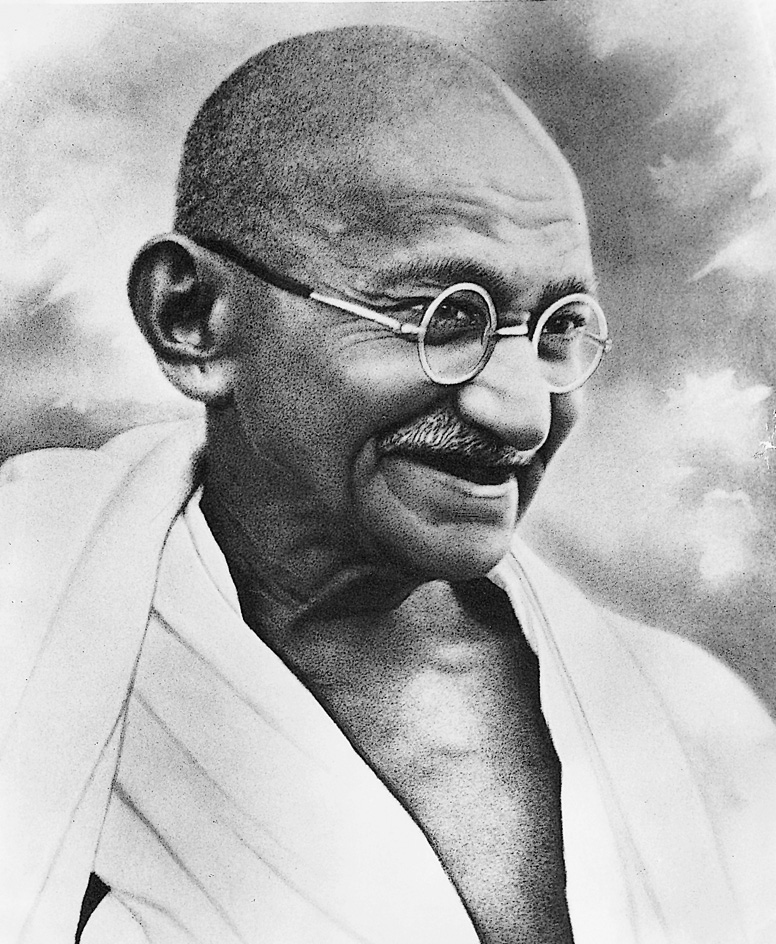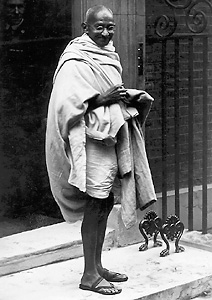Gandhi, Mohandas Karamchand << GAHN dee or GAN dee, `moh` huhn DAHS `kur` uhm CHUHND >> (1869-1948), was one of the foremost spiritual, political, moral, and cultural leaders of the 1900’s. He helped free India from British control by using a unique method of nonviolent resistance. Gandhi is honored by the people of India as the father of their nation. He was slight in build but had great physical and moral strength. He was assassinated by an Indian who resented his program of tolerance for all creeds and religions.
Gandhi’s beliefs.
The people called Gandhi the Mahatma (Great Soul). His life was guided by a search for truth. He believed truth could be known only through tolerance and concern for others and that finding a truthful way to solutions required constant testing. He called his autobiography My Experiments with Truth. Gandhi overcame fear and taught others to master fear. He believed in nonviolence and taught that to be truly nonviolent required courage. He lived a simple life and thought it was wrong to kill animals for food or clothing.

Gandhi developed a method of direct social action, based upon principles of courage, nonviolence, and truth, which he called Satyagraha. In this method, the way people behave is more important than what they achieve. Satyagraha was used to fight for India’s independence and to bring about social change.
Gandhi’s early life.
Gandhi was born on Oct. 2, 1869, in Porbandar, India. His parents belonged to a Vaisya (merchant) caste of Hindus. Young Gandhi was a shy, serious boy. When he was 13 years old, he married Kasturba, a girl the same age. Their parents had arranged the marriage. The Gandhis had four children.
Gandhi studied law in London. He returned to India in 1891 to practice law, but he met with little success.
In 1893, Gandhi went to South Africa to do some legal work. South Africa was then under British control. Almost immediately, he was abused because he was an Indian who claimed his rights as a British subject. He saw that all Indians suffered from discrimination. His law assignment was for one year, but he stayed in South Africa for 21 years to work for Indian rights.
Gandhi led many campaigns for Indian rights in South Africa and edited a newspaper, Indian Opinion. As part of Satyagraha, he promoted civil disobedience campaigns and organized a strike among Indian miners. He was arrested many times by the British, but his efforts brought important reforms. Gandhi also worked for the British when he felt justice was on their side. He was decorated by them for paramedic work in the Anglo-Boer War of 1899-1902 and the Zulu Rebellion (1906).
Gandhi’s independence campaigns.
In 1914, Gandhi returned to India. Within five years, he became the leader of the Indian nationalist movement.
In 1919, the British imperial government introduced the Rowlatt bills to make it unlawful to organize opposition to the government. Gandhi led a Satyagraha campaign that succeeded in preventing passage of one of these bills. The other was never enforced. Gandhi called off the campaign when riots broke out. He then fasted to impress the people with the need to be nonviolent. His belief in the cruelty of imperial rule was demonstrated by the Amritsar Massacre of April 13, 1919. A British general ordered his men to fire on an unarmed crowd, and almost 400 Indians were killed. This made Gandhi even more determined to develop Satyagraha and to win independence through nonviolent resistance.
Gandhi began a program of hand spinning and weaving around 1920. He believed the program (1) aided economic freedom by making India self-sufficient in cloth; (2) promoted social freedom through the dignity of labor; and (3) advanced political freedom by challenging the British textile industry and by preparing Indians for self-government.

In 1930, Gandhi led hundreds of followers on a 240-mile (386-kilometer) march to the sea, where they made salt from seawater. This was a protest against the Salt Acts, which made it a crime to possess salt not bought from the government. During World War II (1939-1945), Gandhi continued his struggle for India’s freedom through nonviolent disobedience to British rule. He was jailed for the last time in 1942. Altogether, he spent seven years in prison for political activity. He believed that it is honorable to go to jail for a good cause.
Loading the player...Dandi march
Freedom and death.
India was granted freedom in 1947. But the partition of India into India and Pakistan grieved Gandhi. He was saddened also by the rioting between Hindus and Muslims that followed. Gandhi had worked for a united country, and he had urged Hindus and Muslims to live together in peace.
On Jan. 13, 1948, at the age of 78, Gandhi began his last fast. His purpose was to end the bloodshed among Hindu, Muslim, and other groups. On January 18, their leaders pledged to stop fighting and Gandhi broke his fast. Twelve days later, in New Delhi, while on his way to a prayer meeting, Gandhi was assassinated. Nathuram Godse, a Hindu fanatic who opposed Gandhi’s program of tolerance for all creeds and religions, shot him three times.
A shocked India and a saddened world mourned Gandhi’s death. The great scientist Albert Einstein said of Gandhi: “Generations to come will scarcely believe that such a one as this walked the earth in flesh and blood.”
